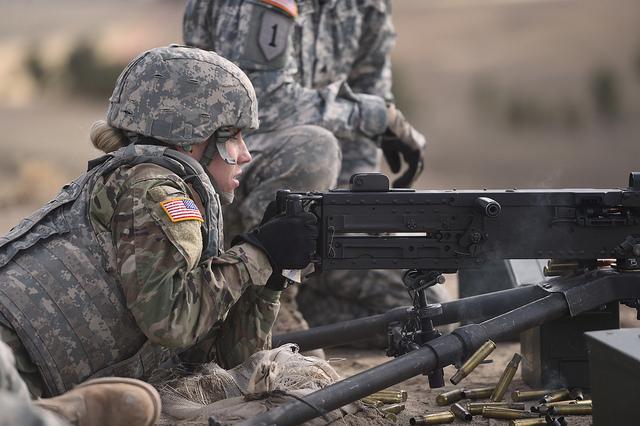
Welcome to the first-ever Women, Peace and Security wrap here at The Strategist. On the first Monday of each month, we’ll be covering developments in the WPS agenda and highlighting their impacts on national security.
When women become infantry(men)
On 19 May, the first 18 female trainees graduated from US Army infantry training at Fort Benning, Georgia. It was a historic moment, but Army Times was keen to get on with business as usual; everybody is measured against the same benchmark, and basic training for women is the same as for men. The attrition rate for the female trainees was around 50%, but that didn’t stop anonymous reports from within the unit suggesting that some physical standards had been lowered. Those suggestions were hotly disputed by the graduates, as recounted to Task and Purpose. Keen as the Army was to downplay the moment, the women’s achievement didn’t get past The New York Times, which reported that they were each carrying ‘heavy packs and the weight of history’.
For an Australian perspective on diversifying the military, check out this Strategist interview with Defence Force Chief, Air Chief Marshal Mark Binskin.
Indonesia’s first female Ulama congress
While much attention has been paid to Islam’s perceived undercutting of tolerance in Indonesia, you might’ve missed the inaugural National Congress of Women’s Ulama (religious scholars) in Cirebon. The prominent gathering of international Ulama issued a series of fatwas against marital rape, child marriage and environmental destruction. UNICEF has labelled the fatwa urging the Indonesian government to raise the marriage age from 16 to 18 a ‘landmark moment’ in the country where child marriages comprise 35% in some regions—some of the highest in the world. As Valerie Hudson’s work has shown, marriage age is an indicator of a state’s instability.
Women fighting ISIS
For insight into one woman’s experience on the battlefield, VICE’s women’s interest channel, Broadly, brings us a three-part diary from Kimberly Taylor, the first British woman to fight alongside Kurdish forces in Syria. It’s an at times bloody account of boots on the ground, but it provides a valuable look into the lives of those in the Women’s Protection Units, the all-female affiliate army of the People’s Protection Units in Kurdish Syria.
Protection & Prevention: conflict-related sexual violence
The UN Security Council Open Debate on ‘Sexual Violence in Conflict as a Tactic of War and Terrorism’ highlighted the continued gap between the ‘protection’ and ‘prevention’ pillars of WPS. Of the 69 statements made by member states, 77% referenced protection but only 52% referenced conflict prevention. As PeaceWomen argues, the unbalanced framing of the issue serves to cement women’s victim-status and ignores the fact that ‘protection is not the solution to victimisation—empowerment is’.
Importantly, Deputy Secretary-General Amina Mohammed argued sexual violence in conflict was no longer viewed ‘merely as a women’s issue’ but as a ‘legitimate threat to security and durable peace that requires an operational security and justice response’. To that end, the Secretary-General’s 2017 report on Conflict-Related Sexual Violence (PDF) continues to provide recommendations to the Security Council, member states and regional organisations on efforts to stop it. Many of the recommendations are worth consideration as Australia looks ahead to the next iteration of its National Action Plan (NAP) on Women, Peace and Security due in 2019.
Women and countering violent extremism
On 4 May, the GSDRC produced a report for the Australian government examining existing literature on women and CVE, and whether such research can be linked to the WPS agenda. For those with some time on their hands (it’s 36 pages!), it makes for interesting reading, not least because it highlights the diverse roles women play in violent extremism and the effects their positions have on extremist organisations.
The report also included several recommendations for promoting integration of CVE and WPS agendas. A key point was the need to develop and update the NAP on WPS to ensure that it integrates a CVE dimension. Back in March, ASPI analyst, Sofia Patel, wrote about the complexities associated with incorporating CVE into Australia’s NAP and whether such a step would ‘add real value’ (PDF). The Civil Society Report Card released on 11 May highlighted CVE as an ‘emerging issue’ (PDF). Interestingly, only 6% of Australian respondents described CVE as a priority issue for Australia’s implementation of the WPS agenda. Despite that, the Report Card reiterated the need for the second NAP to demonstrate a ‘nuanced understanding’ of extremism, informed by research and gender analysis, ensuring that ‘all CVE programming integrates gender as a cross-cutting issue’.
Crucial to these efforts, however, is the need to examine the larger issue of female/male relations and their effects on all dimensions of national security. Speaking in an interview with the ASPI Editors, Valerie Hudson argued that we risk undermining the effects of gender-focused CVE programs if we see ‘only the tactical or instrumental advantage of including women’.
If you’ve enjoyed this wrap and would like to continue to satiate your WPS appetite, Foreign Policy has compiled a neat list of women in national security Twitter accounts worth following.